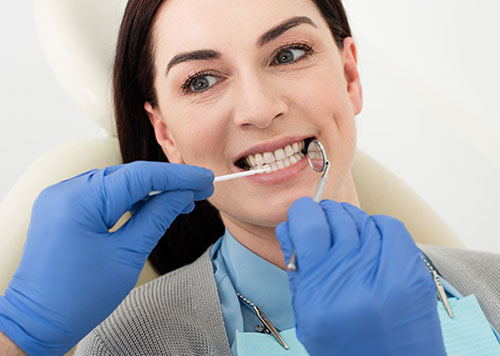
Experienced Periodontal Care
Optimal periodontal health with full, healthy gums is the foundation for strong teeth which can significantly contribute to good overall well-being and quality of life. Peter O. Cabrera, DDS, and Bahareh Sabzehei DDS, MS help patients achieve optimal oral health with expert periodontal care and maintenance using innovative treatment techniques and advanced technology.
We also believe that preserving and obtaining ideal gum health is a joint effort. When it comes to treating the essential structures of your smile, we walk you through every aspect of your treatment and emphasize the importance of communication and education.
We take the time to establish trust when providing expert guidance and essential instructions regarding what you should be doing at-home to prevent conditions that could jeopardize oral and gum tissue health.
Schedule your periodontal consultation with Dr. Peter Cabrera or Dr. Bahareh Sabzehei and their team to explore your options towards a healthier, functional, and better smile today!
What Does Periodontics Involve?
Periodontics is a specialized field of dentistry that focuses on diagnosing, preventing, and treating your gums as well as the surrounding structures that are responsible for holding your teeth in place.
The primary goal of periodontics is to achieve and maintain ideal periodontal health and ensure that long-lasting function, health, and beauty remains throughout your smile.
What Services are Considered Periodontics?
Periodontal care encompasses specialized services to improve your gum health, including:
- Periodontal examinations
- Detailed, digital x-rays
- Tooth scaling & root planing
- Antibiotic treatment
- Laser technology
- Gum tissue regeneration
- Pocket depth reduction
- Pocket irrigation
- Gum Grafts
- Bone Grafts
- Sinus lifts
- Ridge modifications
- Crown lengthening
- Dental implants
Periodontal treatment methods depend upon the type and severity of gum disease or other conditions. Dr.s Cabrera and Sabzehei will evaluate your oral health and recommend the appropriate treatment.
After reviewing your digital x-rays and performing a thorough periodontal exam, they will discuss your treatment options, answer questions, and explain what happens next.
How is a Periodontist Different from a General Dentist?
A periodontist is a dental professional who specializes in the prevention, diagnosis, and treatment of periodontal disease, and in the placement of dental implants. Periodontists receive extensive training in these areas, including three additional years of education beyond dental school. A specialist uses the latest techniques for diagnosing and treating periodontal disease, and are also trained in cosmetic periodontal procedures.
Periodontists can treat many cases ranging from mild gingivitis to more severe periodontitis and gum tissue recession. Periodontists offer a wide range of treatments like removing infected tissues, eliminating oral bacteria, reversing lost jawbone dentistry and tissue, and many other procedures. Periodontists can also perform surgical procedures for patients with severe gum disease.
Additionally, periodontists are trained in the placement, maintenance, and repair of dental implants.
What is Gum Recession?
Gum recession is the process in which the tissue that surrounds the teeth pulls away or recedes, exposing more of the teeth, or the tooth roots. When gum recession occurs, “pockets,” or gaps can form between the teeth and gums, making it easier for disease-causing plaque and bacteria to build up. If left untreated, the teeth, supporting tissues, underlying jawbone, and other structures can become damaged and lead to tooth loss.
Gum recession is a common dental problem. Most people don’t know they have it because it occurs gradually. The first sign of gum recession is usually tooth sensitivity, or you may notice a tooth looks longer than usual.
Why Did My Gums Recede in the First Place?
Below are 9 common factors that could contribute to your gums receding:
- Gum disease – Gum disease is a buildup of bacteria and tartar leading to an infection that attacks important periodontal structures, like gums, teeth, tooth roots, and the jawbone. Periodontal disease is the most common cause of gum recession. The early stage of periodontal disease is not often painful and symptoms often go unnoticed. If left untreated it can develop into periodontitis, the most severe stage of gum disease.
- Improper oral hygiene – Neglecting to brush, floss, and rinse with antibacterial mouthwash daily can make it easy for plaque to grow in abundance and to turn into tartar. Tartar is a hard substance that forms on and between your teeth that can only be removed by a professional cleaning. The toxins in plaque and tartar begin to irritate the gums and they will start to pull away from teeth.
- Orthodontic treatment – Teeth moved outside of the bone as a result of orthodontic treatment can have root exposure. Fixed lingual wires sometimes have memory in their shape have a tendency to gradually reposition teeth over time.
- Brushing or flossing too hard – Brushing your teeth too aggressively or incorrectly can cause enamel to wear away and gums to recede. Flossing too aggressively can also cause gum tissue to become irritated.
- Genetics – Due to hereditary factors, some people are more susceptible to periodontal disease and/or gum recession because of limited gum tissue. Some individuals have an overabundance of gum tissue, resulting in a “gummy” looking smile, and others can have the opposite problem with a lack of natural gum tissue.
- Hormone levels – Changes in estrogen levels during puberty, pregnancy, and menopause, can make gums increasingly sensitive and vulnerable to gum recession.
- Tobacco products – Smokers and tobacco users are more likely to develop gum disease due to the sticky plaque which can build up.
- Grinding and/or teeth clenching – Clenching or grinding your teeth can exert too much force and put pressure on the blood vessels that nourish the gums.
- Crooked teeth or a misaligned bite – Miss-alignment can complicate gum disease by making it difficult to keep critical areas clean and free of debris. Food particles and plaque can lead to decay, infection, and gum irritation.
How is Gum Recession Treated?
Gum recession is not something you want to ignore. If you think your gums are receding, make an appointment with our periodontist. We have treatments that can help repair the gums and prevent further damage.
Treatments for gum tissue recession often include the following:
Deep cleanings: We use special tools to remove the plaque and tartar buildup on the roots of teeth where the gums are receding. This procedure is also known as root planing.
Gum grafting: This involves taking gum tissue from a healthy area and using it to replace the receded gum tissue. It is a quick and relatively simple surgery that can drastically improve your gum health.
Regeneration: In severe cases of gum recession the underlying bone may already be destroyed. However, with specialized and innovative treatment regenerative material is placed in the area of bone loss to help restore bone and tissue.
Gum recession can occur slowly, sometimes over several years. If you notice that your teeth appear longer, or the spaces in between appear larger at the base, contact our periodontist, as these are typically the early warnings signs indicating you may need gum recession treatment.
Understanding Gum Disease and The Impact it Has on Your Health

Gum, or periodontal disease, is an oral infection that develops when oral hygiene is neglected. Oral bacteria that feed on particles of carbohydrate-rich foods can get left behind after a meal. The bacteria metabolize carbohydrates and produce plaque acids, which release toxins into your body . The bacteria and plaque can be removed with brushing, but if the teeth aren’t brushed, the plaque hardens into tartar.
Tartar, along with the presence of bacteria, irritates the gums and causes inflammation and early gum recession. This stage is known as gingivitis, the earliest form of gum disease.
Without proper treatment, gingivitis can advance into periodontitis. As the disease advances it damages gum tissue, impacting jawbone volume and the overall health of the smile. The gums become more swollen, and can look puffy and deep red or purple. They may bleed more easily and start to pull away from the teeth. The eventual result of untreated periodontitis is tooth loss.
The effect of blood pressure medications on gum health

This is Dr. Peter Cabrera. Today we are going to speak about something that doesn’t receive the amount of attention that it deserves, and that is the effect of blood pressure medications on gum health.
First of all, some background. Heart disease is the leading cause of death in the United States. One person dies from heart disease every 34 seconds. Almost 700,000 people died from heart disease in 2020. One out of every five deaths is due to cardiovascular disease, and according to the CDC, the cost of managing heart disease is almost $230 billion a year. There are a number of factors that significantly contribute to heart disease, the one that we’re going to be discussing today is hypertension. High blood pressure, according to the Mayo Clinic, can be controlled with lifestyle but also with medications. One classic medication is called calcium channel blockers, and of those, there are two of particular interest, which are Amlodipine and Nifedipine, also known as Norvasc and Procardia. These are known to cause gum overgrowth. Typically what happens the gum begins to overgrow; this is a side effect. In between the teeth and we believe that on plaque, bacterial plaque is the main source of the irritant that causes the overgrowth. With time these lesions that begin in between the teeth can coalesce and form almost a wall cover part or all of the teeth. In this particular situation, we’re looking at a 53-year-old female who has been on Amlodipine for two years and whose chief complaint is that her gums are bleeding over several months. The overgrowth causes a bacterial trap; with more bacteria, we get more inflammation and overgrowth, so it is essentially a vicious cycle. The treatment or the management has to do with medical number one, finding an alternate drug in both in terms of the periodontal health the gum health, which involves just basically detail cleaning so you can see in this case of this patient, the pretreatment it was basically some deep cleaning and a little bit of time and medication, were able to significantly reduce the overgrowth and in addition limit, the amount of surgical intervention required so although in this particular situation there may be some residual overgrowth surgical correction will be minor if at all if it’s needed at all and again this is the same patient with the same overgrowth.
So, in summary, certain blood pressure medications can have an effect on the gums by creating overgrowth as a side effect.
Although some individuals think surgery is always the answer, the need for surgical intervention can be significantly decreased with appropriate management.
When to Call a Periodontist
There are multiple reasons why you may need the expertise of a periodontist. If you any of the following signs and/or symptoms listed below, be sure to seek proper periodontal care promptly. This is essential for the health of your gums, jawbone, teeth, and overall smile.
- Red, swollen or tender gums
- Gum discoloration, from deep reds to purples
- Persistent pain
- Unpleasant taste
- Bleeding gums while brushing and flossing
- Gums that are receding or pulling away from the teeth
- Tooth loss
- Increased sensitivity
- Chronic sores or white spots
- White spots on gums
- Persistent bad breath
- Changes in your bite
Treating Gum Disease
Before initiating any form of gum disease treatment, our periodontist will examine your gums, jawbone and the general condition of your teeth. When gingivitis or periodontal disease is officially diagnosed, Dr. Cabrera and Dr. Sabzehei have a number of surgical and non-surgical options available to treat the underlying infection. Each treatment is designed to halt the recession of gums and other soft tissue and restructure or replace teeth that may be missing.
Scaling & Root Planing: This procedure involves careful deep cleanings of the root surfaces to remove plaque and tartar from deep periodontal pockets and smoothing the tooth root to remove bacterial toxins. Scaling and root planing is sometimes followed by antibiotics as needed. Some patients will require ongoing maintenance therapy to sustain oral health.
Laser Treatment: Lasers are used for treating moderate to severe forms of gum disease. This treatment is an innovative, non-surgical approach to eliminating infection and restoring gum tissue health. With lasers, we can access and remove the harmful bacteria beneath the gums. This technology can also disinfect areas, greatly reducing bleeding, swelling, and discomfort.
Pocket Reduction: This procedure promotes proper healing in gum tissues, encouraging them to reattach after scaling and root planing. During treatment, the gum tissue is folded back to remove the disease-causing tartar then secured back into place.
As a preventive measure, treatment with antibiotics is often administered either before or after your periodontal procedures.
Ensure Your Overall Gum Health
The goal of periodontal care is to encourage a healthy mouth, and Peter O. Cabrera and Bahareh Sabzehei are expert periodontists, dedicated to tracking your progress as you make your way to a healthier smile. We encourage you to continue visiting us after initial treatment for follow up appointments and maintenance.
Schedule an appointment for an examination in Chicago today!


